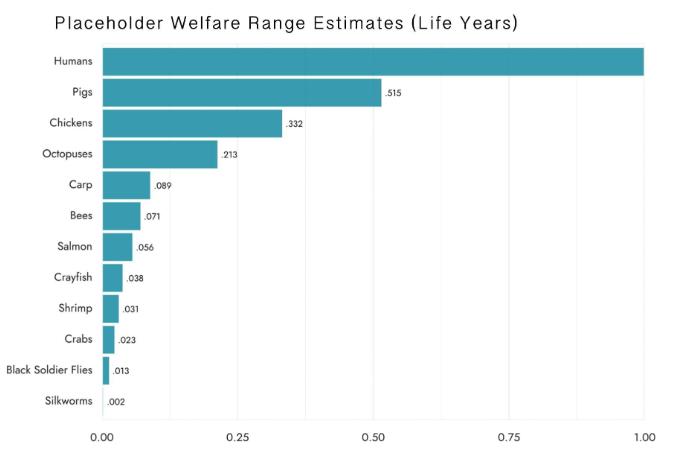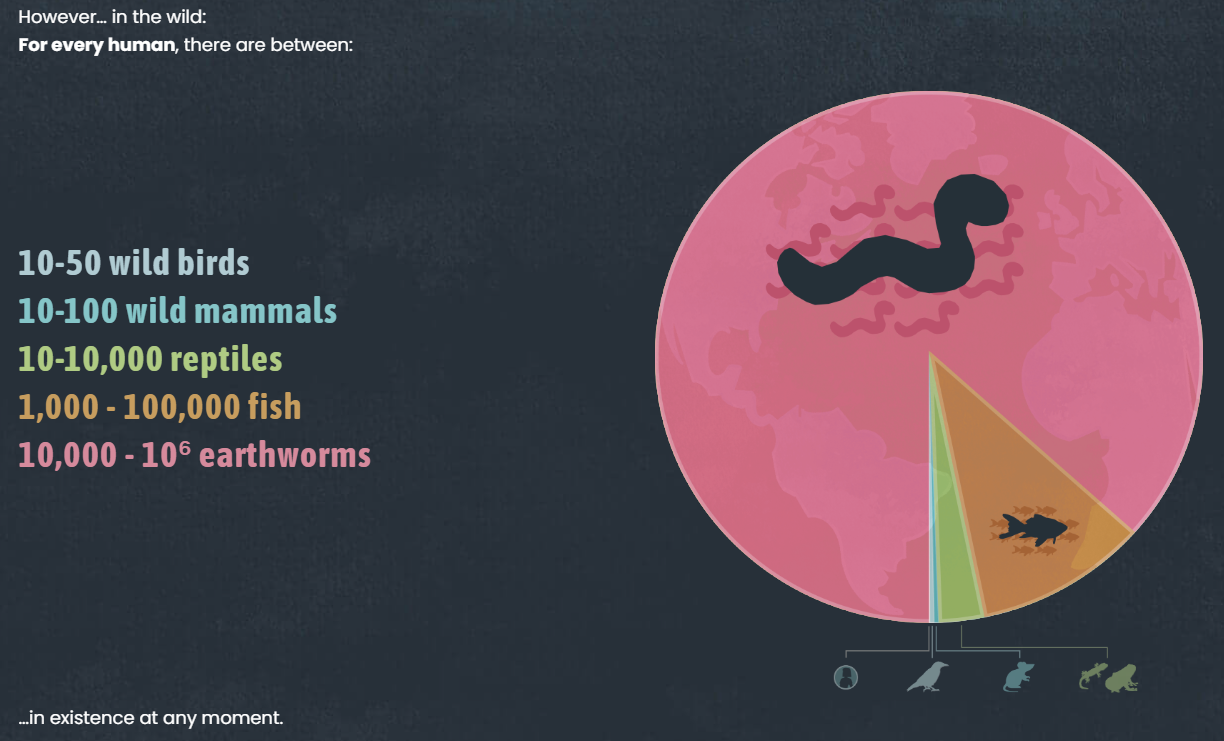In August 2022, I started making summaries of the top EA and LW forum posts each week. This post collates together the key themes I’ve seen within top-rated animal welfare posts since then. Note a lot of good work is happening outside what's posted on the forum too! This post doesn't try to cover that work. It's also a blog post and not a research report - meaning it was produced quickly and is not to our (Rethink Priorities') typical standards of substantiveness and careful checking for accuracy.
If you’re interested in staying up to date on a more regular basis, consider subscribing to the Weekly EA & LW Forum Summaries, or to the Animal Advocacy Biweekly Digest. Forum announcements here and here.
And for a great overview of the good the community is doing in this space, I highly recommend reading Big Wins for Farm Animals This Decade by Lewis Bollard.
Key Takeaways
- A multi-proxy method has been suggested as a better option than neuron counts for estimating the moral weights of different species, with a first stab completed by Rethink Priorities based on empirical and philosophical research.
- There is an increasing focus on small animal welfare eg. fish, crustaceans and insects. This is particularly relevant for interventions which may cause substitution effects (consumers moving from one form of animal product to another).
- Wild animal welfare is becoming a more established cause area, with recent launches including WildAnimalSuffering.org and the NYU Wild Animal Welfare Program.
- Several major policy wins were achieved, including the first FDA approval of cultivated meat, and an EU announcement that it would put forward a proposal to end the systematic killing of male chicks.
Themes
Cross-Species Comparisons
Moving beyond neuron counts
Big strides have been made in modeling cross-species welfare comparisons.
Rethink Priorities published the Moral Weight Project Sequence (led by Bob Fischer), which tackles philosophical and empirical questions related to the relative welfare capacities of 11 different farmed animals. This included looking at the evidence for 90 different hedonic and cognitive proxies in those animals, discussing why we shouldn’t just use neuron counts, and publishing a model of relative differences in the possible intensities of these animals’ pleasure and pains (relative to humans). You can see the results below - they suggest using these as the best-available placeholders until further research can be completed, and noting the translation from intensity of experience (welfare range) into ‘moral weight’ is dependent on several philosophical assumptions:
Other work in this area has included:
- The launching of the NYU Mind, Ethics, and Policy Program, which will conduct and support foundational research about the nature and intrinsic value of nonhuman minds, including biological and artificial minds. There will be a special focus on invertebrates and AIs.
- The Shrimp Welfare Project (founded 2021) released research on using biological markers to measure the welfare of shrimp, and prioritize the practices causing the worst harms.
- MHR points out the issues with using neuron counts extend to the practical as well as the philosophical - the only publicly-available empirical reports of fish neuron counts sample exclusively from very small species (<1 g bodyweight), while many farmed fish are 1000x larger. This should add extra skepticism to neuron-count-based estimates of the moral weight of farmed fish.
- Rethink Priorities released research on welfare considerations for farmed black soldier flies - anticipated to become the most farmed insect species in the next decade.
The danger of substitution effects
A team of entomologists and philosophers from Iran, the UK, and the USA found strong or substantial evidence for pain in adult insects of five orders, and ishankhire attempted to model cricket suffering per kg consumed and found this much higher than suffering caused by other forms of animal farming.
Stijn found that switching from beef to chicken or insect meat reduces climate change but increases animal suffering many times over.
Anima international suspended their campaign to end live fish sales in Poland, after realizing it may cause a shift in preferences from Carp to Salmon - the latter of which is carnivorous and requires feed fish, so would involve far more suffering per kg farmed overall.
Taken together, these suggest a growing awareness of the danger in substitution effects ie. moving consumers from one form of animal product to another. As our evidence for the moral weight of smaller animals grows, they are getting an increased focus within EA.
Wild Animal Welfare

Image from WildAnimalSuffering.org
Wild animal welfare is a relatively new cause area, with potentially massive scale. Over the past 6 months, EAs have launched two new resources for outreach in this area:
- WildAnimalSuffering.org, a website by Vegan Hacktivists, with visually engaging and accessible information on issues surrounding wild animal suffering. Announcement here.
- The NYU Wild Animal Welfare (WAW) program, which aims to use research and outreach to advance understanding about wild animals. Sign up here to receive email updates.
In addition, the Wild Animal Initiative received $400K in funding from the Animal Welfare Fund in April 2022 to cultivate an academic field dedicated to wild animal welfare.
Policy
Wins
The past 6 months have seen some major policy wins for farmed animals:
- The US Food and Drug Administration (FDA) gave its first safety approval to a cultivated meat product startup.
- The EU announced it would put forward a proposal to end the systematic practice of killing male chicks across the EU.
This comes off the back of wins earlier in 2022, which saw fish welfare discussed at UK parliament for the first time ever, the welfare of crabs & lobsters & prawns recognized in the new Animal Welfare (Sentience) Bill in the UK, and 161 new organisations worldwide commit to using cage-free products. Thanks to Shakeel Hashim for collecting these and many other 2022 wins in EA.
Lobbying
EAs have been gathering data relevant to lobbying in animal welfare:
- Animal Ask investigated the academic literature on lobbying, and found it had many well-known weaknesses, and wasn’t suitable for gauging counterfactual impact.
- On September 25th the Swiss electorate had the opportunity to vote to abolish factory farming. It didn’t pass, but 37% voted in favor, with 52% participation.
- A US nationally representative survey by Rethink Priorities found 15.7% supported a ban on slaughterhouses (when given arguments framed around animal welfare for and against, and asked to explain their reasoning).
- Pax Fauna’s study on animal welfare narratives found that ‘futility’ (“my change won’t matter if the world doesn’t change too”) was a large barrier to action. Promoting pro-animal policies over individual consumption decisions, and focusing on societal progress in messaging were effective tools for combatting this.
Potential Allies
RobertY suggested working with the beef industry to reduce consumption of small animals like chickens, in favor of beef. This approach draws on a growing body of research that the majority of animal agriculture suffering is from small animals (eg. chicken, fish, invertebrates). However, many comments noted the reputational risk of this approach.
In another case of advocating for reduced enmity, Aidan Kankyoku suggests that the “welfarism vs. abolitionism” framing is obsolete, with all parties working on different increments toward the same goal. Having some people trying to change decision-making and policy from the inside via moderate demands, and some trying to change the norms of the world as a whole via more radical demands, makes for a stronger movement overall.
Value Lock-In
Some posters have argued that if we don’t push to end factory farming now via moral arguments (as opposed to practical ones), we’ll risk locking in speciesism for the long run.
Fai initially argued this point, and then updated based on comments toward a strategy of advancing moral advocacy once animal product consumption is significantly reduced (<20% of current). BrainK links to a Forbes article referring to What We Owe the Future that suggests AGI may lock-in current values, including how we think about animals on factory farms. And Omnizoid suggests that we may have thrown out abolitionism without enough consideration of its benefits - including its focus on moral progress, that could later translate to increased caring for wild animal suffering.
Appendix - individual post summaries
You can check out all the individual summaries of top-rated animal-welfare posts from August 2022 to the end of January 2023 here.

This blog post is an output of Rethink Priorities–a think tank dedicated to informing decisions made by high-impact organizations and funders across various cause areas. The author is Zoe Williams. Thanks to Peter Wildeford for their guidance, and Bob Fischer, Meghan Barrett and Jacob Peacock for their helpful feedback.
If you are interested in RP’s work, please visit our research database and subscribe to our newsletter.

I think this was a very interesting article due to just how many proxies can be used to gauge animal suffering (and that it’s possible to accurately gauge it at all), the fact that research into wild animal suffering is now being taken quite seriously, I didn’t know how many forward-thinking policies have been put in place to promote animal welfare (in particular, that cultured meat is already starting to be approved as safe, as well as parliament’s serious consideration of the welfare of smaller, supposedly less sentient animals like prawns and shrimp); and lastly, that it’s the smallest animals that experience the most amount of suffering relative to larger (supposedly more sentient) animals.
I found nearly all of this very surprising, as a lot of my intuitive assumptions are violated as a result, and the animal welfare movement is much more robust than I initially thought. Now I definitely need to rethink my eating habits, as I am a pescetarian who only eats prawns (as opposed to other fish, beef, chicken, etc.) due to their seemingly negligible sentience. Finally, I didn’t think it’s possible that more moderate demands and more radical demands wouldn’t conflict with one another and ultimately hamper the animal welfare movement. I think maybe the opposite of what I intuitively thought is true because letting these ideas coexist means that the animal welfare movement doesn’t have to be as cautious; additionally, the more ideas that are out there, the more attention is drawn to the movement as a whole and the more people will get involved. Maybe there’s also the added effect that seeing a robust debate occur within the movement makes it, in a sense, more flexible and less morally rigid: only some people prescribe more radical approaches and choices, so it isn’t like the entire animal welfare movement is looking down on and judging the average person.
I'm curious, how do you think about the relative importance of promoting cell-based (cultivated) vs. plant-based meat?
Interesting question, thanks for adding this! I don't have any background in animal welfare research or the plant/cell based meat area beyond reading & chatting with people, but popped some thoughts below regardless:
My leaning would be that having both is better than just one, to provide increased choice and options to move away from traditional meats. I'm not sure I buy the fourth point - while there will be some competition between plant-based and cell-based meat, they also both compete with the currently much larger traditional meat market, and I think there are some consumers who would eat plant-based but not cell-based and vice versa. Not only taste, look, feel, and cost are relevant but also the optics and cultural connotations of each, which are quite different.
In terms of proportion of promotion efforts to each, I'm really not sure. A strategy there should probably look at how developed each tech is (so more plant-based meat promotion earlier on), uptake rates and effect of promotion (and if there's a ceiling hit where we struggle to get further uptake in a population, suggesting a new option is needed for those remaining), populations promoted to and their unique concerns / likelihood to uptake one or the other, and any tipping points or opposition that needs to be countered in a timely way for something to remain viable in a location or to get past legislative hurdles.
(Also sorry for the late reply! I was on vacation last week)
"I'm not sure I buy the fourth point - while there will be some competition between plant-based and cell-based meat, they also both compete with the currently much larger traditional meat market, and I think there are some consumers who would eat plant-based but not cell-based and vice versa."
The evidence I've seen (Source) suggests that consumers are largely confused about the difference between cell-based and lab-based meats, which doesn't help sales of either. Also, cell-based meats are currently HORRIBLE for animal rights given the amount of suffering they cause to cow fetuses (Source). If consumers started conflating the issues with cell-based meats and plant-based meats, it would be a large setback to the industry. And given how largely the traditional dairy market has been lobbying against plant-based milks (Source), I don't think it's unreasonable to expect that they might intentionally blur the lines between cell-based and plant-based meats to find whatever arguments they can against alternative meats.
Thank you for putting this together!